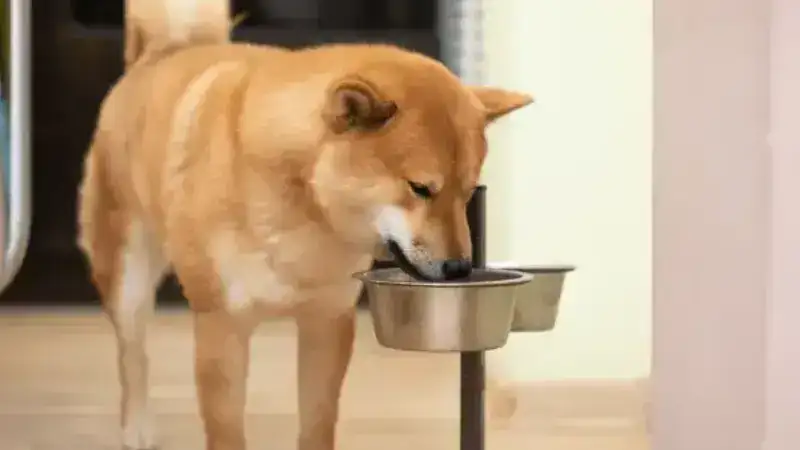Introduction
As a dog owner, you always want to ensure that your dog stays healthy and happy. One common concern many pet parents have is whether certain human foods are safe for their dogs. Among these foods, a frequently asked question is: can dogs have goldfish? Whether you’re referring to the popular snack known as Goldfish crackers or the actual aquatic pet, it’s essential to understand the potential risks before sharing anything with your furry friend. This article will dive deep into whether dogs can consume Goldfish crackers or actual goldfish, the risks involved, and safer alternatives.
Understanding Goldfish Crackers: What’s in Them?
Goldfish crackers are a popular snack among both children and adults. They’re small, fish-shaped, and often seasoned with various flavors. The original variety, typically cheese-flavored, is the most common type. But before giving them to your dog, let’s break down the ingredients to see if they’re dog-friendly.
Goldfish crackers usually contain:
- Enriched wheat flour
- Cheese
- Salt
- Vegetable oils
- Onion powder
- Garlic powder
- Artificial flavorings
At first glance, these ingredients might not seem harmful, but they can pose health risks to dogs. Some of these components are especially dangerous for canine consumption, and even a small amount can lead to long-term health issues. Contact us for more details.
Are Goldfish Crackers Safe for Dogs?
The simple answer is no, dogs should not eat Goldfish crackers. While the snack is perfectly safe for humans, several of the ingredients are harmful to dogs. Here’s a breakdown of why Goldfish crackers are not suitable for your canine companion:
- High Salt Content Dogs are sensitive to salt, and too much salt can lead to dehydration, vomiting, diarrhea, and even sodium ion poisoning. While a small amount of salt may not cause immediate harm, frequent consumption can have long-term effects on a dog’s health. Excessive salt intake can also lead to increased thirst, which may put pressure on their kidneys.
- Garlic and Onion Powder Both garlic and onion are toxic to dogs. Even in small amounts, they can damage your dog’s red blood cells, leading to anemia. Symptoms of garlic and onion toxicity in dogs include weakness, lethargy, vomiting, and difficulty breathing. Long-term exposure can cause more severe health issues.
- High in Fats and Carbohydrates Goldfish crackers are rich in fats and carbohydrates, which are not ideal for dogs. While dogs need fats in their diet, unhealthy fats found in snacks like Goldfish can lead to weight gain, pancreatitis, and other obesity-related diseases. High levels of carbohydrates can spike blood sugar levels, contributing to canine diabetes over time.
- Artificial Ingredients Artificial flavors and preservatives are common in Goldfish crackers, and these can irritate a dog’s digestive system. Many dogs have sensitive stomachs, and the consumption of artificial ingredients can lead to vomiting, diarrhea, and other gastrointestinal issues.
Can Dogs Eat Live Goldfish?
It’s also crucial to address the consumption of actual goldfish, particularly for households that have both dogs and fish as pets. Dogs might occasionally be curious and try to consume live or dead goldfish from an aquarium. But is this safe?
The answer is again, no. There are several reasons why eating a live or dead goldfish can be harmful to your dog:
- Bacteria and Parasites: Fish can carry harmful bacteria like salmonella or parasites that can cause digestive issues and infections in dogs.
- Bones: Goldfish bones can pose a choking hazard or cause internal injuries, such as punctures or blockages in the digestive tract.
- Toxic Substances: If the goldfish was living in an aquarium, the water might contain chemicals like ammonia or nitrates, which are dangerous to dogs when ingested.
What to Do If Your Dog Eats Goldfish Crackers
If your dog has accidentally consumed a small number of Goldfish crackers, they might not show any immediate signs of distress. However, it’s essential to watch for potential symptoms like vomiting, diarrhea, excessive thirst, or lethargy.
In most cases, a small amount might not cause serious harm, but if your dog has consumed a larger quantity or you notice any of the symptoms mentioned, it’s best to contact your veterinarian immediately. Your vet may recommend monitoring your dog at home or bringing them in for further evaluation.
What to Do If Your can dogs have goldfish Eats an Actual
If your dog has eaten a live or dead goldfish, it’s critical to monitor them closely. Here are some steps you can take:
- Monitor for Symptoms: Keep an eye on your dog for any signs of vomiting, diarrhea, lethargy, or abdominal pain.
- Contact Your Vet: If your dog starts showing any of these symptoms or if you know they’ve consumed a significant portion of the goldfish, reach out to your vet. Your vet may advise treatment depending on your dog’s health and the amount consumed.
- Check the Aquarium: Ensure that your aquarium is safe and that any chemicals used in the water do not pose additional risks if ingested.
Healthier Alternatives to can dogs have goldfish Crackers
Fortunately, there are many dog-safe snacks that your furry friend can enjoy. If you’re looking for healthy alternatives to share with your dog, consider these options:
- Carrot Sticks Carrots are low in calories and packed with fiber and beta-carotene. They can help improve your dog’s dental health as they chew, making them a great crunchy snack.
- Apple Slices Apples are another great snack for dogs. They are rich in vitamins A and C and contain plenty of fiber. Just be sure to remove the seeds, as they contain cyanide and can be harmful to dogs.
- Blueberries Blueberries are packed with antioxidants and make for a perfect bite-sized snack for your dog. They’re low in calories and full of nutrients that can benefit your dog’s overall health.
- Peanut Butter Peanut butter is a favorite among dogs. It’s rich in healthy fats and protein. However, ensure the peanut butter you choose does not contain xylitol, an artificial sweetener toxic to dogs.
- Plain Rice Cakes Rice cakes are another healthy alternative to Goldfish crackers. They are low in salt and free from harmful ingredients. Just make sure they’re plain with no added flavors or seasonings.
Training Your Dog to Avoid Harmful Foods
Preventing your dog from eating harmful foods is crucial for their long-term health. Training your dog to avoid unsafe foods is essential, and the following tips can help:
- Teach the “Leave It” Command Teaching your dog the “leave it” command can prevent them from eating harmful items. This training can save them from accidentally consuming dangerous foods or objects.
- Supervise During Snack Time Ensure that snacks are stored in high, secure places where your dog can’t reach them. Avoid feeding your dog while you’re snacking on something potentially harmful to them.
- Educate Family Members It’s important to make sure everyone in the household knows which foods are safe for the dog and which are not. Kids especially may be tempted to share their snacks with the dog without realizing the potential harm.
Why Dogs Should Avoid Human Snacks
Dogs have different nutritional needs from humans. Many human snacks, including Goldfish crackers, are packed with unhealthy ingredients like salt, sugar, and fats that are not suited for canine digestion. Over time, feeding your dog human snacks can lead to:
- Obesity: High-calorie snacks can cause your dog to gain weight quickly.
- Pancreatitis: Consuming too much fatty food can inflame the pancreas, leading to this painful and dangerous condition.
- Diabetes: Sugary snacks can spike your dog’s blood sugar levels, increasing the risk of diabetes.
Can Puppies can dogs have goldfish Crackers?
Puppies are particularly sensitive to what they eat. Their digestive systems are still developing, and introducing harmful snacks like Goldfish crackers can disrupt their growth. Puppies require a diet rich in nutrients to ensure proper development, and feeding them unhealthy snacks can lead to long-term health problems, including weight issues, nutrient deficiencies, and digestive complications.
The Importance of a Balanced Diet for Dogs
A dog’s diet should consist primarily of high-quality dog food designed to meet all their nutritional needs. This includes:
- Protein: For muscle development and energy.
- Healthy Fats: For a shiny coat and proper brain function.
- Carbohydrates: For energy, but from healthy sources like sweet potatoes or grains.
- Vitamins and Minerals: To support various body functions and maintain overall health.
Feeding your dog a balanced diet will not only keep them physically healthy but will also help them maintain a good temperament, stay active, and avoid behavioral issues linked to poor nutrition.
Consulting Your Vet About Your Dog’s Diet
If you’re unsure about what foods are safe for your dog, it’s always a good idea to consult your veterinarian. Vets can provide expert advice on which foods are safe, how much your dog should be eating, and recommend any necessary supplements or dietary changes.
Conclusion
So, can dogs have Goldfish? Whether you’re referring to the cheesy snack or the actual fish, the answer is no. Both options pose significant risks to your dog’s health. From toxic ingredients in Goldfish crackers to bacteria and choking hazards from live fish, neither is safe for canine consumption. It’s crucial to prioritize your dog’s health


Before installing the Metamask extension, I was worried about scams, but https://download.metaredi.org/ made everything clear and secure. I appreciate their well-written guides that ensure a safe setup process. Highly recommended for everyone!
Thanks to https://metamaker.org/#metamask-download, I was able to download Metamask quickly and without any confusion. Their instructions are beginner-friendly, and I love how they explain each step clearly. Now I can manage my crypto securely!
Thanks for sharing. I read many of your blog posts, cool, your blog is very good.
Thank you for your sharing. I am worried that I lack creative ideas. It is your article that makes me full of hope. Thank you. But, I have a question, can you help me?
Thanks for sharing. I read many of your blog posts, cool, your blog is very good.
Can you be more specific about the content of your article? After reading it, I still have some doubts. Hope you can help me.
MetaMask Download is essential for beginners. The interface is simple, and it guides users step-by-step to secure their digital assets.
I don’t think the title of your article matches the content lol. Just kidding, mainly because I had some doubts after reading the article.